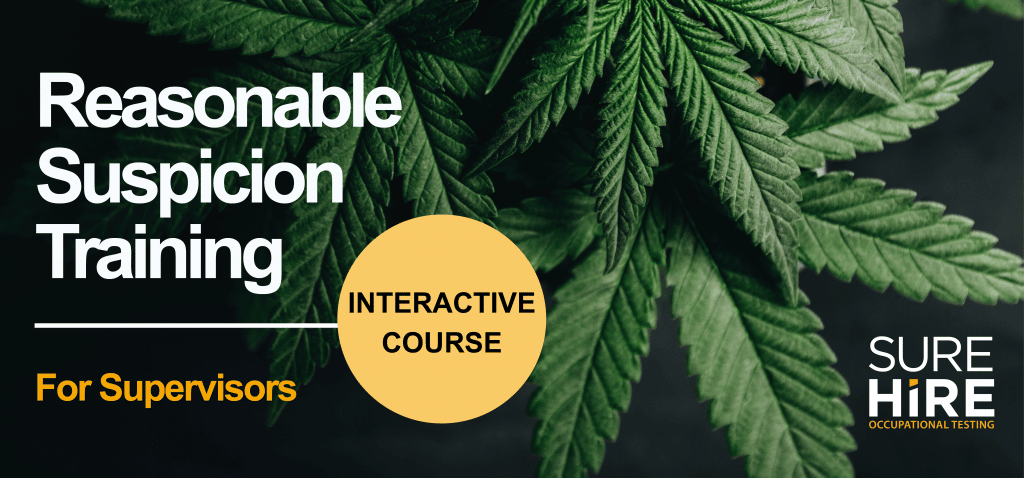TAKEAWAY: Drug use harms workplace health and safety, work quality, productivity, and the business’s bottom line. Here are 6 signs your employees may be abusing drugs and some preventative measures you can take to if you suspect impairment on the job site.
Jump Ahead
- Book Impairment Awareness Training Today!
- Signs employers can look out for if they suspect employees of drug abuse
- A combination of signs
- What should employers do if they suspect drug impairment on the job site?
- What can employers do to help educate their workforce and prevent the risk of impairment-related incidents and injuries?
- You May Also Be Interested In…

Book Impairment Awareness Training Today!
SureHire offers impairment awareness training to help supervisors and employees understand how to identify signs of drug abuse and when to carry out reasonable suspicion testing. We offer private sessions both virtually and in-person as well as self-study session through our online learning centre iNTELLECT.
Employee substance abuse has an adverse effect at an individual and a company-wide level. Addiction costs American businesses an estimated $81 billion annually in lost profits, with mining, construction, and the accommodation and food service industries generally showing the highest prevalence of substance use.
Drug abuse negatively affects employers because it can increase absenteeism, turnover, compensation claims, violence, and theft. It compromises the safety of the drug abuser and others around them. The majority of substance abusers maintain employment and operate at a functional level, highlighting the need for employers to understand the potential workplace implications of substance abuse.
Ultimately, drug use harms workplace health and safety, work quality, productivity, and the business’s bottom line. Therefore, employers should understand how to identify signs of drug abuse and what to do on the job site when they suspect an employee is under the influence of drugs.
Signs employers can look out for if they suspect employees of drug abuse
It’s essential to recognize that there isn’t a definitive list of drug abuse signs. Sometimes drug abuse signs could be indicative of something else altogether. Employers can look for several signs if they suspect employees are using illicit drugs.
1. Behaviour
A sudden behaviour change may be indicative of substance abuse. Examples include:
- A sudden disinterest in work
- Neglecting responsibilities
- Regularly showing up late or calling in sick
- Lack of energy or motivation
- Risk-taking or making dangerous choices
- Secretive or suspicious behaviour
2. Change in performance
Employees who start making mistakes and display a drop in overall performance could be affected by drugs or alcohol. They may have difficulty concentrating on tasks or remembering things, decreased reaction time, and reduced mental sharpness.
3. Impaired motor function
Impaired motor skills are a sign of drug use. Look out for employees who appear unsteady on their feet. They might be swaying, staggering, falling over, or holding onto something to keep upright.
The person’s movements could be slow, and they may appear sleepy or disorientated. Conversely, they could be hyperactive or act nervously.
4. Physical appearance
An employee abusing drugs may start having a general lack of interest in clothing or grooming. They may wear dirty clothes and have a smelly or dirty body. Drug and alcohol users could smell like alcohol, tobacco, or chemicals.
Look at the person’s face for other signs. Their eyes might be watery, bloodshot, or glassy, with dilated or constricted pupils. Their skin may appear pale, flushed, or sweaty.
Signs around the mouth include slobbering or chewing gum or candy.
5. Speech
A person’s speech patterns can indicate drug use. An employee under the influence of drugs or alcohol could sound slurred or incoherent and may speak very slowly.
6. Personality
A drug-impaired employee could have drastic mood swings. They might suddenly act hostile, angry, paranoid, or fearful for no apparent reason. Other unexplained changes in attitude or personality could be a sign of drug abuse.
A combination of signs
An employee abusing drugs will likely present with several signs rather than one in isolation. Some are commonly associated with certain classes of drugs. For example, drugs like amphetamines, methamphetamine, and cocaine are stimulants that may present as increased energy, alertness, and restlessness. Conversely, slower reaction times and reduced coordination more likely indicate marijuana use.
Essentially, employers should pay attention to any drastic changes in an employee’s behaviour, performance, physical appearance, and personality and seek to find the cause, which may or may not be drug-related. Drug testing is the only definitive way to confirm substance abuse.
What should employers do if they suspect drug impairment on the job site?
Companies should have a clearly defined workplace drug and alcohol testing policy. As part of that, employers should document a course of action for reasonable suspicion should they suspect an employee is under the influence of drugs or alcohol. Steps employers can take in the case of alleged impairment include:
- Document complaints and concerns brought forward from co-workers in detail.
- Talk to the employee in person and observe any suspected signs of impairment. Then ask another supervisor or human resources (HR) representative to conduct a first-hand observation.
- Remove the employee from any safety-sensitive area if they may be putting themself or others at risk.
- Both observers should document their observations of abnormal behaviours, speech, appearance, odours, emotions, actions, or inactions.
- Determine whether observations and documentation support reasonable suspicion and if there is disagreement, bring in a third party to decide if further steps are necessary.
- Meet with management, HR, and the employee to explain the observations. Inform the employee that the company will send them for a drug and alcohol test to rule out the possibility of violation of the drug and alcohol policy.
- Arrange transportation to the testing facility, either in a taxi or with a management team member.
- Wait for test results and then respond to an employee’s refusal to take the test, or to a positive or negative result, as per the company’s drug and alcohol policy.
The 8-Panel drug test is the most popular screening test because it tests for the most commonly abused drugs. These are:
- Amphetamine
- Cocaine
- Methamphetamine
- Phencyclidine (also called PCP or angel dust)
- Cannabis/marijuana
- MDMA (methylenedioxymethamphetamine, also known as ecstasy or molly)
- Opioids (heroin and synthetic opioids such as fentanyl)
- Oxycodone (Roxicodone and OxyContin)
What can employers do to help educate their workforce and prevent the risk of impairment-related incidents and injuries?
Drug abuse is a sensitive subject that can leave employers feeling unsure about an appropriate course of action. Reasonable suspicion testing can confirm substance abuse, yet the employer must understand when it’s ok to do it and the consequences if it’s done incorrectly.
At the same time, employers must take steps toward ensuring the health and safety of their workers. A drug-free workplace helps reduce the likelihood of drug-related accidents and injuries, ultimately helping to protect the workforce.
Employers must understand how to identify signs of drug abuse and when to carry out reasonable suspicion testing. Reasonable suspicion training is a cost-effective solution to educating supervisors and employees about the adverse effects of alcohol and drugs on workplace safety.
[Find out more about SureHire’s Reasonable Suspicion Training Programs].

Browse Our Drug & Alcohol Services
SureHire offers a range of drug and alcohol testing services, including DOT and non-DOT random testing, alcohol testing, drug testing, and mobile testing. Our Substance Abuse Support Services use professional support personnel to help employers assess employees with a disclosed substance abuse problem or those who have tested positive on a drug and alcohol test. These services help prevent discrimination and protect workers’ rights. [Learn more]
You May Also Be Interested In…
- Do You Have Reasonable Suspicion?
 Employers cannot initiate reasonable suspicion testing without first going through the 5-step process. Reasonable suspicion training provides critical information about how to initiate reasonable suspicion testing, including the 5-step process and other tools that employers can use to help manage the misuse of alcohol and drugs in the workplace.
Employers cannot initiate reasonable suspicion testing without first going through the 5-step process. Reasonable suspicion training provides critical information about how to initiate reasonable suspicion testing, including the 5-step process and other tools that employers can use to help manage the misuse of alcohol and drugs in the workplace. - An Employer’s Guide: What You and Your Employees Need to Know About DOT Drug & Alcohol Testing
 When implementing or maintaining DOT Drug & Alcohol testing, there are key areas that employers should consider.
When implementing or maintaining DOT Drug & Alcohol testing, there are key areas that employers should consider. - SureHire Occupational Testing Acquires COHR Health: A Positive Step Towards Safe, Healthy, Productive Workforces and Communities
 We are thrilled to announce that today, May 6, 2024, SureHire Occupational Testing has officially acquired COHR Health, a well-known leader in occupational health services. Read on…
We are thrilled to announce that today, May 6, 2024, SureHire Occupational Testing has officially acquired COHR Health, a well-known leader in occupational health services. Read on… - Occupational Testing Use Case – Mining
 In this case study, we will explore how mining companies can use various types of occupational tests to reduce Total Recordable Incident Rates (TRIR) long term.
In this case study, we will explore how mining companies can use various types of occupational tests to reduce Total Recordable Incident Rates (TRIR) long term. - 9 Strategies to Keep Workers Cool on Drilling Sites During Hot Summer Months
 This article delves into strategies to keep workers cool and safe on drilling sites during the hot summer months.
This article delves into strategies to keep workers cool and safe on drilling sites during the hot summer months. - Hearing Conservation Basics: How to Manage Occupational Noise
 Learn how to proactively mitigate occupational noise risks and help prevent NIHL among workers.
Learn how to proactively mitigate occupational noise risks and help prevent NIHL among workers.

